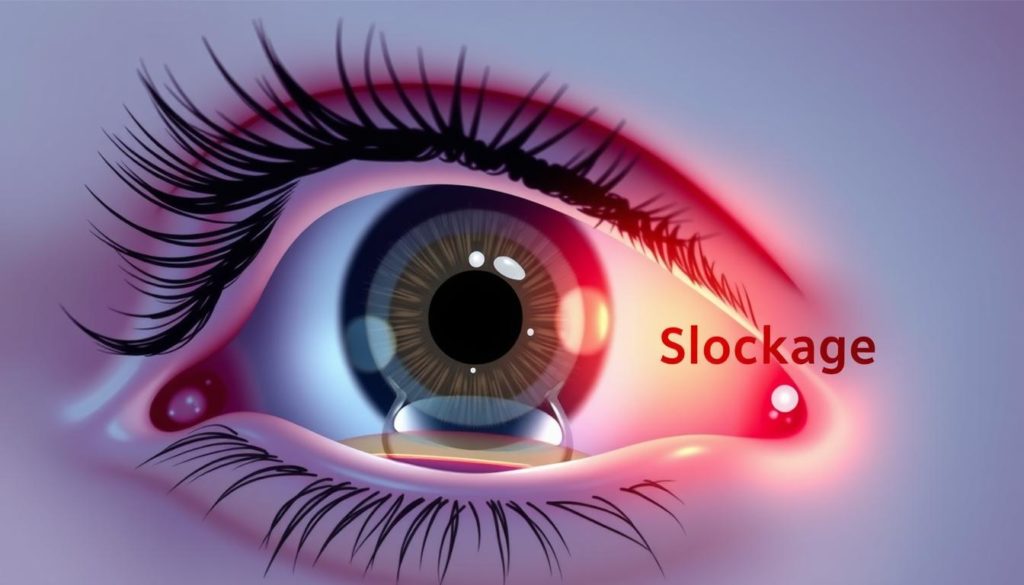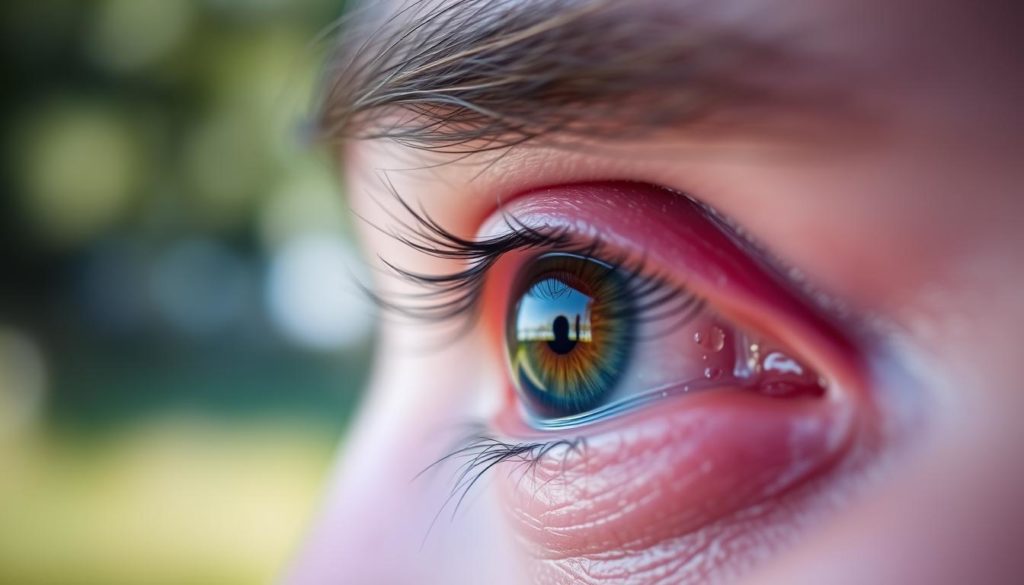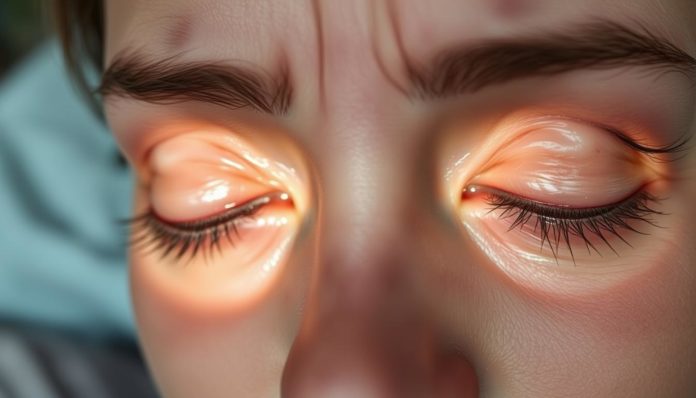Did you know that about 20% of newborns have blocked tear ducts? This issue also affects adults and can harm your eye health. If you’re dealing with constant tearing or eye infections, it’s important to know what’s going on.
This article will explore the symptoms, causes, and treatments for blocked tear ducts. We’ll also share important care tips to keep your eyes healthy. Let’s start our journey to understanding and treating tear duct obstruction.
Understanding Blocked Tear Ducts
A tear duct blockage happens when tears can’t flow out of the eye. This can cause eye discomfort and vision problems. The nasolacrimal duct is key for tear drainage, making sure tears move from the eye to the nose.

A blocked tear duct can make eyes water a lot. This is because tears can’t drain properly. It also causes eye discharge, which can be a big problem.
The nasolacrimal duct is vital for eye health. Without it, eyes can get irritated and infections are more likely.
Here are some important points about tear duct blockages:
- People with blocked ducts often have watery eyes.
- It can cause eye discharge and infections.
- Getting a diagnosis and treatment early is key to avoid more problems.
Knowing about tear duct blockages helps us see why we need to keep tear drainage healthy. We should fix any blockages quickly.
Common Symptoms of Blocked Tear Ducts
Blocked tear ducts can cause a lot of discomfort. It’s important to know the symptoms early to manage the condition well.

Excessive Tearing
One clear sign of blocked tear ducts is too much tearing. This is because the tear ducts can’t drain properly. People might always be wiping their eyes, feeling like they’re always crying.
Recurring Eye Infections
Blocked tear ducts often lead to eye infections. This is because tears can’t move freely and become a place for bacteria to grow. People might see redness, feel pain, and get conjunctivitis or other eye problems often.
Swelling Around the Eyes
Swelling and tenderness around the eyes are common signs. Fluid buildup can make the area look puffy. This swelling can hurt, especially when touched.
Discharge from the Eyes
Discharge from the eyes or crusty eyes in the morning is a sign. This discharge can be watery or thick and sticky. It makes the eyelids stick together, showing there’s a problem.
Here is a summary of common symptoms associated with blocked tear ducts:
| Symptom | Description |
|---|---|
| Excessive Tearing | Constant watery eyes due to drainage obstruction |
| Recurring Eye Infections | Frequent conjunctivitis and other infections |
| Swelling Around the Eyes | Puffiness and tenderness around the eye area |
| Discharge from the Eyes | Mucous or watery discharge, leading to crusty eyes |
Causes of Tear Duct Blockage
Blocked tear ducts can be caused by many things. These include being born with it, injuries, and changes that come with age. Knowing what causes it helps find the right treatment and ways to prevent it.
Congenital Blockages
Congenital blocked tear ducts are common in babies. This happens when the tear ducts don’t open right at birth. Often, it fixes itself by the first year. But, if it doesn’t, doctors might need to step in.
Injuries and Infections
Getting hurt in the face or having surgery can block tear ducts. Infections like conjunctivitis or long-term inflammation can also block them. Quick treatment is key to managing these problems.
Age-related Changes
As we get older, our tear ducts can narrow. This makes them more likely to get blocked. Regular doctor visits and catching problems early can help deal with these age-related issues.
Here’s a quick rundown of why tear ducts might get blocked:
| Cause | Description |
|---|---|
| Congenital Blockages | Common in infants due to underdeveloped tear ducts |
| Traumatic Injury | Resulting from facial injuries or surgeries |
| Infections | Infections like conjunctivitis causing inflammation |
| Age-related Changes | Narrowing of tear ducts due to aging |
Blocked Tear Ducts in Adults
Dealing with blocked tear ducts can be tough for adults. There are many reasons why it happens and it can be a long-term problem. Many adults find it very uncomfortable and it really gets in the way of their daily life.
It’s important to know the signs of blocked tear ducts in adults. These signs are not the same as in babies. They might be less obvious but can be more serious if not treated right away.
Adults with blocked tear ducts might notice:
- Persistent tearing or watery eyes
- Frequent eye infections
- Swelling and redness around the eyes
- Mucus or pus discharge from the eyes
These symptoms can really mess up your day. They can make you feel uncomfortable and affect how you interact with others. First, you might try some simple things at home. But if that doesn’t work, you might need to see a doctor.
| Management Strategies | Details |
|---|---|
| Warm Compresses | Apply a warm, damp cloth over the eye to help loosen debris and encourage drainage. |
| Gentle Massage | Gently massaging the corner of the eye can sometimes help clear minor obstructions. |
| Saline Rinse | Using a sterile saline solution to rinse the eye area can aid in reducing irritation and clearing blockages. |
If home remedies don’t help, a doctor might need to step in. They might use a balloon to open up the duct or put in a stent. This can fix the problem and make your life better again.
Blocked Tear Ducts in Infants
Blocked tear ducts are common in infants, often appearing soon after birth. It’s important to know the symptoms, causes, and treatments to keep their infant eye health in check.
Identifying Symptoms in Babies
Infants with blocked tear ducts show certain signs:
- Excessive tearing
- Recurrent eye infections
- Redness around the eyes
- Persistent discharge in one or both eyes
Common Causes in Infants
One main reason for blocked tear ducts in infants is congenital obstruction. This happens when the tear ducts don’t open right at birth, leading to congenital blocked tear ducts. Other reasons include:
- Underdeveloped tear ducts
- Narrow tear ducts
- Infections or injuries
Treatment Options for Infants
There are several pediatric tear duct treatment options. These aim to ease symptoms and help the ducts open naturally:
| Treatment | Description | When to Use |
|---|---|---|
| Gentle Massage | Light pressure on the tear ducts can open blockages. | Initially, as a first-line treatment |
| Warm Compresses | A warm cloth reduces swelling and promotes drainage. | Daily, to alleviate symptoms |
| Antibiotic Eye Drops | Prescribed to treat any secondary infections. | Under pediatrician’s advice |
| Probing | A minor procedure to open the tear ducts manually. | If conservative treatments fail |
Knowing these methods helps parents manage their child’s infant eye health. They can seek the right pediatric tear duct treatment when needed.
Effective Home Remedies for Blocked Tear Ducts
Blocked tear ducts can be uncomfortable, but there are home remedies that can help. These natural methods offer a gentle and effective way to treat blocked tear ducts. They promote natural eye care.
Warm Compresses
Warm compresses are a popular remedy for blocked tear ducts. The warmth helps loosen the blockage by widening the duct. This makes it easier for fluid to drain.
To use, soak a clean cloth in warm water, wring it out, and place it over your eye. Hold it there for 5 to 10 minutes. Do this several times a day for the best results.
Gentle Massage Techniques
Massaging the tear ducts can also help. Use gentle pressure to massage the area around the tear duct. This encourages fluid to pass through.
Do this with clean hands a few times a day. It’s a simple way to care for your eyes naturally.
Saline Solutions
Saline solutions are another effective remedy. They keep the eye area clean, reducing infection risk. This can help prevent blockages from getting worse.
To use, rinse your eyes with a sterile saline solution. You can find this at most drugstores. It adds to the relief you get from home remedies.
| Remedy | Steps | Frequency |
|---|---|---|
| Warm Compresses | Soak cloth in warm water, apply over the eye | 5-10 minutes, several times daily |
| Gentle Massage | Massage tear duct area with gentle pressure | A few times a day |
| Saline Solutions | Rinse eyes with saline solution | As needed |
Medical Treatments for Blocked Tear Ducts
Blocked tear ducts can be treated with various medical options. These treatments aim to fix the problem and help patients feel better. They ensure the eyes work as they should.
Antibiotic Eye Drops
Antibiotic eye drops are a common treatment for blocked tear ducts. They fight infections that can block tear ducts. This antibiotic therapy for eye infections reduces swelling and kills harmful bacteria.
Balloon Dilation
Balloon dacryoplasty, or balloon dilation, is another effective treatment. A small balloon is inserted into the tear duct. It’s then inflated to widen the duct, improving tear flow. Patients often see fast results and have little downtime.
Stenting or Intubation
For severe cases, tear duct stenting or intubation might be needed. A small tube or stent is placed in the tear duct to keep it open. This method ensures constant drainage and prevents future blockages. Tear duct stenting is great for blockages that don’t get better with other treatments.
Blocked Tear Duct Surgery
When treatments for blocked tear ducts don’t work, surgery might be needed. We’ll look at two main surgeries: Dacryocystorhinostomy (DCR) and endoscopic methods. We’ll also cover important post-surgery care.
Dacryocystorhinostomy (DCR)
DCR surgery creates a new path for tears to drain. It’s done when tear ducts are blocked. A small cut is made on the nose to reach the tear sac. This makes a new way for tears to flow.
Endoscopic Procedures
Endoscopic dacryocystorhinostomy is a less invasive option. It uses a nasal endoscope to clear the blockage. This method has less scarring and quicker healing.
Post-Surgery Care
Good eye care after surgery is key. Patients should keep the area clean and watch for infection signs. They might need antibiotic drops, avoid hard activities, and see doctors for follow-ups.
Dr. Sarah Kim, an ophthalmologist, states, “Following post-surgery care instructions greatly improves surgery success. Proper care helps avoid problems and infections.”
In summary, knowing about blocked tear duct surgery and aftercare is important. Choosing between DCR or endoscopic methods and following care instructions can lead to lasting relief.
When to See a Doctor for Blocked Tear Ducts
Knowing when to visit an eye doctor for blocked tear ducts is key. Seeing a tear duct specialist early can stop problems and help treat them well.
Here are signs you need to see a tear duct specialist:
- Persistent tearing that doesn’t get better with home fixes.
- Eye infections or swelling keep coming back, even after treatment.
- Swelling or redness around the tear ducts is noticeable.
- Eye discharge hints at an infection.
Getting medical advice for eye conditions quickly can avoid long-term pain and serious issues. A detailed tear duct examination by a specialist can give a clear diagnosis and a treatment plan just for you.
Choosing a well-known tear duct specialist means you get the newest treatments and surgery if needed. They can find the blockage’s cause and suggest the best treatments, whether it’s medicine or surgery.
Knowing when and why to see an eye care expert is vital. Relying on them for medical advice for eye conditions leads to quick and right solutions. This improves your eye health and stops problems from coming back.
Preventive Measures for Tear Duct Obstruction
Following a routine of proper eye care tips is key to avoiding tear duct blockage. These practices help keep your tear ducts healthy and lower the chance of blockage.
Daily Eye Hygiene: Good eye hygiene is a top way to keep your tear ducts in check. Wash your face and eyelids with clean water and mild soap. Also, avoid touching your eyes with dirty hands to prevent infections.
Regular Check-Ups: Getting regular eye exams is crucial. They help spot and fix issues early on. These check-ups are essential for maintaining healthy tear ducts.
Say No to Smoking: Smoking can harm your eyes and lead to tear duct problems. Quitting or avoiding second-hand smoke can greatly lower your risk of blockage.
Wear Protective Eyewear: Always wear the right protective eyewear, whether for sports or work with hazardous materials. It helps prevent injuries that could cause blockage.
Nutrient-Rich Diet: Eating a diet rich in nutrients good for your eyes is important. Include Omega-3 fatty acids, vitamins A, C, and E. This supports eye health and helps prevent blockage.
By sticking to these eye care tips and adding these preventive steps to your daily routine, you can greatly reduce the risk of tear duct obstruction. This way, you can enjoy the benefits of maintaining healthy tear ducts.
Conclusion
Understanding and managing blocked tear ducts is key for eye health. Recognizing symptoms like too much tearing and swelling is the first step. This article has shown various treatments, from home remedies to surgery.
Blocked tear ducts can happen to anyone, but it’s different for adults and babies. Babies might have blockages from birth, while adults often get them from injuries or aging. Knowing the cause helps find the best treatment.
Managing blocked tear ducts makes life better and prevents infections. Stay informed and proactive to keep your eyes healthy. If symptoms don’t go away, see a doctor and follow preventive steps.
FAQ
What are blocked tear ducts?
Blocked tear ducts happen when the tear drainage system in your eyes gets blocked. This stops tears from draining properly. Symptoms include too much tearing, eye discharge, and a higher risk of infections.
What are the common symptoms of blocked tear ducts?
Signs of blocked tear ducts include too much tearing, eye infections that keep coming back, swelling around the eyes, and discharge from the eyes. These symptoms can be uncomfortable and may lead to more problems if not treated.
What causes tear duct blockage?
Blockage can be due to being born with it, injuries, infections, or getting older. Each reason has its own treatment options.
How does a blocked tear duct manifest in adults?
Adults might experience long-lasting eye irritation, ongoing infections, and needing to wipe their eyes a lot because of too much tearing. Adults need specific medical care and treatment plans for blocked tear ducts.
Are blocked tear ducts common in infants?
Yes, babies are often born with blocked tear ducts. Symptoms include watery eyes, discharge, and swelling. Most clear up on their own, but sometimes, babies need special treatment.
What home remedies can help with blocked tear ducts?
To help, try warm compresses, gentle massage around the tear ducts, and saline solutions to clean and soothe the eyes.
What medical treatments are available for blocked tear ducts?
Doctors can use antibiotic eye drops, balloon dilation, stenting, or intubation to treat blockages. These methods aim to fix tear drainage and prevent future problems.
When is surgery needed for blocked tear ducts?
Surgery, like Dacryocystorhinostomy (DCR) or endoscopic procedures, is needed when other treatments don’t work. These surgeries create a new tear drainage path and need careful care after.
When should I see a doctor for blocked tear ducts?
See a doctor if you have ongoing symptoms like too much tearing, eye infections that keep coming back, or eye discomfort. A specialist can diagnose and suggest the right treatment.
How can I prevent tear duct obstruction?
To prevent blockages, keep your eyes clean, avoid injuries, and manage infections. Regular eye exams help catch and treat problems early, keeping your tear ducts healthy.


